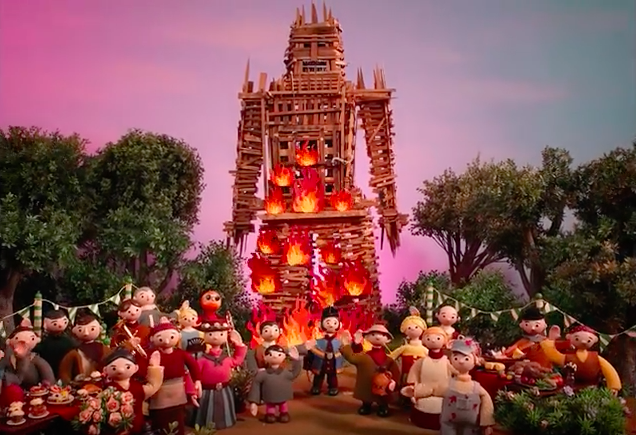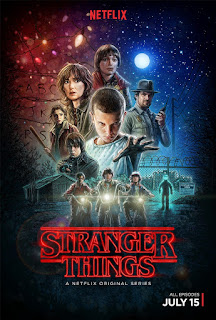Burn the Witch-Radiohead Analysis
Burn the witch - Radiohead
The Burn the Witch video by Radiohead is inspired by the British children’s TV series the 'Trumptonshire Trilogy’. A man is given a tour of a picture-perfect town in which the residents do unspeakably creepy and violent things to each other. The video culminates in the man nearly being burned to death inside a massive wooden effigy — a clear homage to 1973 British horror film ‘The Wicker Man’.
Burn the Witch is created in a clay like form with characters instead of people. The main characters are the inspector going round the village and the presumed mayor of the village showing him round. Multiple eerie settings are shown and 'inspected' as the shocked figure writes things down on a notebook. The song is primarily about burning the witch and also features ritualistic gatherings and eerie scenes. At the start of the video a bird is shown in an idyllic and natural setting with the diegetic sound of nature which primarily sets the scene for a peaceful atmosphere, which we later learn juxtaposes the events that unfold in the video. A tracking shot is then shown as the Inspector is being chauffeured in a car to the ominous village. The scene alternates between the tracking shot and an establishing shot of the village as the mayor talks to the villagers. As the Inspector arrives he initially looks around and the mayor greets him. Noticeably the Inspector rejects the handshake from the mayor which may relate to the immigrant theme presented throughout the video as the Inspector could be presented to be the government/1st world countries who reject the refugees and immigrants, represented here by the villagers and mayor who are not accepted.
In a recent interview with Billboard, the animator behind the video, Virpi Kettu, discussed the motives behind “Burn the Witch”. Interestingly, she believes the video was intended to be happier than the song. “They wanted the video to contrast with what they’re playing and to wake people up a bit,” Kettu explained. Kettu also said that the band wanted the video to raise awareness about Europe’s refugee crisis and the “blaming of different people… the blaming of Muslims and the negativity” currently engulfing European politics. She opined that the band was trying to recreate the climate of fear that politicians have encouraged in response to Muslim immigrants. This is evident in the video as the entire video illustrates the fear of an unknown environment. Arguably the inspector represents the UK and influential/rich countries and the eerie town and townspeople represent the muslims who have twisted and evil connotations put on them. I believe that the video does represent Radiohead as an alternative band as the video offers more of a theatrical element, especially with the clay figurines.
The video then goes on to show the mayor taking the Inspector around the village and showing him the multiple scenes which initially appear innocent yet with a second glance become horrific. They pass a man painting a door red, a colour typically associated with violence and murder, which is presented to be blood. The inspector is then shown a miniature replication of the village which intertextually references the film 'Hot Fuzz' where a similar scene is shown. A medium close up shot is then used as a girl is shown on a chair. The horrific scene is then revealed as the shot turns into an establishing shot showing a see-saw contraption with the previous girl being dunked into a pond which references the witch trials, linking to the lyrics of the song. As the more morbid scenes are revealed the non-diegetic music uses a harsh violin sound to show increased tension and fear.
Further along in the video the mayor shows the inspector an array of food produce on a stall. This initially looks appealing however continuous with the idillic countryside vs. morbid reality theme, a cow is shown to be baked into a pie and is spilling blood onto the floor. We then move to a tomato plantation being picked (through use of the fade in the editing) which again initially seems peaceful however there is reference to Jobe on the tomato crates. The story of Jobe starts in heaven. Satan, the adversary, claims to God that Job is only righteous because he is basically wealthy and comfortable. Satan asks God whether he can test him. He wipes out Job's 10 children, his possessions and gives him a nasty skin disease to boot. Whilst mourning the death of his children three friends increasingly challenge and berate him suggesting that he must have seriously done something wrong to have received such a fate. Job then questions God regarding his suffering, finds Him to be unjust and speaks harshly against God. A fourth companion enters the story, Elihu, and it is Elihu's speech that creates the basis for theodicy. He chastises all, tells us God is never wrong, merciful and that we cannot know or comprehend all that God does. There are greater things than us that we do not and cannot understand. God then turns up, confirms this position and tells everyone that Job is a righteous man and that the three people who mocked him should make a sacrifice and that Job will forgive them. The story ends with Job receiving his wealth back several fold, having another 10 children and living for another 140 years.
Overall this religious story could arguably relate to the political context of Burn the witch as the story questions why good things happen to supposedly good people, which links to the immigration issues that surround the song and fuel the ideologies.
Towards the end of the music video the Inspector is taken to a large structure which is covered with a red sheet. The producers have made a conscious decision to use a red sheet to portray the blood and violence we have previously seen in the video. The non-diegetic music quickens in pace as the singing becomes louder and higher in octave to convey the tension and fear of the inspector. The red sheet is removed to reveal a large wooden structure which references the horror film 'The Wicker man' which (as previously mentioned) ends with the outsider protagonist being burnt alive amongst animals in the wooden effigy. In the video the screeching violin begins again as the Inspector climbs into the wicker man to show the horror and fear. This continues as the effigy is lit and the villagers turn to the camera in an establishing shot and wave, mimicking an ending to a children's TV programme (thus linking to the Trumptonshire Triology). This scene is horrifically juxtaposing as we have the Inspector being burned in the background with the villagers waving creating an idylic setting amongst the sinister background.
The video concludes with a cyclical plot featuring the bird from the beginning. The camera pans down to show the Inspector with scorch marks showing that he escaped from the fire, leaving the audience with pleasure as the predicament has been resolved.
The audience may gain a sense of nostalgia from Radiohead's video due to the Tumptonshire trilogy and the wicker man references. This therefore creates pleasure as it creates the sense of recognition to the audience. The structure of the video is also cyclical so would again bring pleasure to the audience as it begins with the bird and ends with the same bird. Fans especially would gain pleasure as it is a release of a new song.
The Burn the Witch video by Radiohead is inspired by the British children’s TV series the 'Trumptonshire Trilogy’. A man is given a tour of a picture-perfect town in which the residents do unspeakably creepy and violent things to each other. The video culminates in the man nearly being burned to death inside a massive wooden effigy — a clear homage to 1973 British horror film ‘The Wicker Man’.
Burn the Witch is created in a clay like form with characters instead of people. The main characters are the inspector going round the village and the presumed mayor of the village showing him round. Multiple eerie settings are shown and 'inspected' as the shocked figure writes things down on a notebook. The song is primarily about burning the witch and also features ritualistic gatherings and eerie scenes. At the start of the video a bird is shown in an idyllic and natural setting with the diegetic sound of nature which primarily sets the scene for a peaceful atmosphere, which we later learn juxtaposes the events that unfold in the video. A tracking shot is then shown as the Inspector is being chauffeured in a car to the ominous village. The scene alternates between the tracking shot and an establishing shot of the village as the mayor talks to the villagers. As the Inspector arrives he initially looks around and the mayor greets him. Noticeably the Inspector rejects the handshake from the mayor which may relate to the immigrant theme presented throughout the video as the Inspector could be presented to be the government/1st world countries who reject the refugees and immigrants, represented here by the villagers and mayor who are not accepted.
In a recent interview with Billboard, the animator behind the video, Virpi Kettu, discussed the motives behind “Burn the Witch”. Interestingly, she believes the video was intended to be happier than the song. “They wanted the video to contrast with what they’re playing and to wake people up a bit,” Kettu explained. Kettu also said that the band wanted the video to raise awareness about Europe’s refugee crisis and the “blaming of different people… the blaming of Muslims and the negativity” currently engulfing European politics. She opined that the band was trying to recreate the climate of fear that politicians have encouraged in response to Muslim immigrants. This is evident in the video as the entire video illustrates the fear of an unknown environment. Arguably the inspector represents the UK and influential/rich countries and the eerie town and townspeople represent the muslims who have twisted and evil connotations put on them. I believe that the video does represent Radiohead as an alternative band as the video offers more of a theatrical element, especially with the clay figurines.
The video then goes on to show the mayor taking the Inspector around the village and showing him the multiple scenes which initially appear innocent yet with a second glance become horrific. They pass a man painting a door red, a colour typically associated with violence and murder, which is presented to be blood. The inspector is then shown a miniature replication of the village which intertextually references the film 'Hot Fuzz' where a similar scene is shown. A medium close up shot is then used as a girl is shown on a chair. The horrific scene is then revealed as the shot turns into an establishing shot showing a see-saw contraption with the previous girl being dunked into a pond which references the witch trials, linking to the lyrics of the song. As the more morbid scenes are revealed the non-diegetic music uses a harsh violin sound to show increased tension and fear.
Further along in the video the mayor shows the inspector an array of food produce on a stall. This initially looks appealing however continuous with the idillic countryside vs. morbid reality theme, a cow is shown to be baked into a pie and is spilling blood onto the floor. We then move to a tomato plantation being picked (through use of the fade in the editing) which again initially seems peaceful however there is reference to Jobe on the tomato crates. The story of Jobe starts in heaven. Satan, the adversary, claims to God that Job is only righteous because he is basically wealthy and comfortable. Satan asks God whether he can test him. He wipes out Job's 10 children, his possessions and gives him a nasty skin disease to boot. Whilst mourning the death of his children three friends increasingly challenge and berate him suggesting that he must have seriously done something wrong to have received such a fate. Job then questions God regarding his suffering, finds Him to be unjust and speaks harshly against God. A fourth companion enters the story, Elihu, and it is Elihu's speech that creates the basis for theodicy. He chastises all, tells us God is never wrong, merciful and that we cannot know or comprehend all that God does. There are greater things than us that we do not and cannot understand. God then turns up, confirms this position and tells everyone that Job is a righteous man and that the three people who mocked him should make a sacrifice and that Job will forgive them. The story ends with Job receiving his wealth back several fold, having another 10 children and living for another 140 years.
Overall this religious story could arguably relate to the political context of Burn the witch as the story questions why good things happen to supposedly good people, which links to the immigration issues that surround the song and fuel the ideologies.
Towards the end of the music video the Inspector is taken to a large structure which is covered with a red sheet. The producers have made a conscious decision to use a red sheet to portray the blood and violence we have previously seen in the video. The non-diegetic music quickens in pace as the singing becomes louder and higher in octave to convey the tension and fear of the inspector. The red sheet is removed to reveal a large wooden structure which references the horror film 'The Wicker man' which (as previously mentioned) ends with the outsider protagonist being burnt alive amongst animals in the wooden effigy. In the video the screeching violin begins again as the Inspector climbs into the wicker man to show the horror and fear. This continues as the effigy is lit and the villagers turn to the camera in an establishing shot and wave, mimicking an ending to a children's TV programme (thus linking to the Trumptonshire Triology). This scene is horrifically juxtaposing as we have the Inspector being burned in the background with the villagers waving creating an idylic setting amongst the sinister background.
The video concludes with a cyclical plot featuring the bird from the beginning. The camera pans down to show the Inspector with scorch marks showing that he escaped from the fire, leaving the audience with pleasure as the predicament has been resolved.
The audience may gain a sense of nostalgia from Radiohead's video due to the Tumptonshire trilogy and the wicker man references. This therefore creates pleasure as it creates the sense of recognition to the audience. The structure of the video is also cyclical so would again bring pleasure to the audience as it begins with the bird and ends with the same bird. Fans especially would gain pleasure as it is a release of a new song.



Comments
Post a Comment